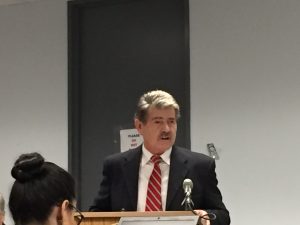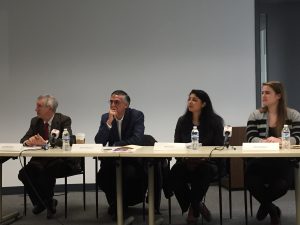Does Chicago have a TIF addiction?
By Jean Lotus Staff Reporter — March 7, 2017
Cook County Clerk David Orr speaks at a panel discussion on Tax Increment Financing districts. (Chronicle Media)
Cook County Clerk David Orr hosted a discussion March 2 about an economic development tool some call a “political slush fund” and others a community-saving economic shot in the arm.
Tax Increment Finance (TIF) districts, Orr said, are “a pot of gold that taxpayers don’t understand. It’s pretty ingenious how you can raise money [for capital projects] from taxpayers without them even knowing it,” Orr said.
One-third of Chicago’s landmass, and one out of every five Chicago real estate parcels lies inside a TIF district overlay. TIFs generated nearly half-a-billion dollars in 2014, and six Chicago area TIFs generated more than $20 million each in 2015, according to Orr’s office.
“Chicago’s use of TIF is extraordinary compared to other cities of its size,” said David Merriman, University of Illinois professor of government and public affairs.
TIF districts were developed as a property tax diversion scheme to allow politicians to subsidize developers to build in blighted areas. The 23- to 30-year TIF mechanism supposedly pays for redevelopment activity with anticipated increased property tax revenues from the redevelopment project itself — or the area nearby. The municipality freezes the tax base of properties in the TIF district. As property values rise, money that would have flowed to park districts, schools and libraries is collected in an “increment” and diverted to a fund to be used at the discretion of the mayor and local aldermen.
Even more confusing: Money generated by one district can be “ported” to an adjoining district making accountability even more difficult.
Some say TIFs lock up property tax money and starve other taxing bodies, such as school districts, libraries and the city itself, of vital tax revenues over decades.
Last year, to stem a Chicago Public School funding crisis, the City of Chicago agreed to release a multimillion-dollar TIF surplus subsidy for the schools.
There were 146 TIF districts in Chicago alone in 2015, more than all the districts combined in 10 other major U.S. cities, such as New York City, Philadelphia, Dallas Houston and others, Merriman said.
TIFs were invented in California in the 1950s, but that state recently dissolved all TIFs and demanded that schools, libraries and other taxing bodies be made whole of diverted tax revenue.
TIFs in other states have more stringent rules including limits on acreage, said Alex Gilewicz of the Better Government Association.
Making TIFs transparent is a challenge because private developers do not want trade secrets, like company earnings and subsidies, leaked. Orr’s office calculates the tax revenue generated by TIFs throughout the county. The searchable county TIF website can search for TIF overlays by PIN number or on maps. Grand totals of TIF funds are also published by Orr’s office.
“Why have TIF at all? Merriman asked. “From my point of view the city could raise taxes and have a capital development plan.”
Former Chicago Mayor Richard Daley was accused of using a TIF shell-game to port revenue from poor areas of the city to subsidize luxury development downtown. Several downtown TIFs have been shut down early, said panelist Aarti Kotak, deputy commissioner of the Department of Planning and Development.

: Panelists at the discussion were (from left) David Merriman, Chicago 22nd Ward Ald. Rick Munoz, Aarti Kotak and Alex Gilewicz. (Chronicle Media)
Under Mayor Rahm Emanuel’s term, Kotak said 15 TIFs have expired and two have been eliminated.
What are TIFs good for? Kotak said TIF funds were ported from several neighboring zones to Englewood to prepare the site for a Whole Foods, Chipotle and Starbucks chains. TIF funds totaling $10 million were used to consolidate 130 different parcels in this project, she said.
“The developer could not have consolidated that land,” she said. “This is beautiful, what this neighborhood has deserved all along.”
She said an update of Garfield Park conservatory and recreation centers in Bronzeville and Morgan Park all had financing “unlocked” with money from an adjacent TIF zone.
“The reality in communities in need is that these are not communities where we can let the market do what it does,” Kotak said. “If we left it to the market and didn’t intervene with city funds, we’d leave behind thousands of the most vulnerable residents,” she said.
Ald. Rick Munoz (22nd Ward), and 32nd Ward Ald. Scott Waguespack belong to a group of Progressive Caucus aldermen who are asking for more stringent rules for TIF districts. “TIF Back to Basics,” A proposed new rule sponsored by Waguespack, would guarantee that any TIF project corresponded to an area of blight. The proposed ordinance would only supply city TIF money to projects that could not be built without it — a “but, for” clause.
Munoz said there were two types of TIF, those devoted to a specific project and more speculative TIFs, where villages or cities “TIF a neighborhood and see what happens,” he said. “Those TIFs are dangerous and lead to speculation and gentrification,” Munoz said. Munoz, Waguespack and Merriman agreed that the decisions for these types of development needed to be made in public, transparent processes.
— Does Chicago have a TIF addiction? —






